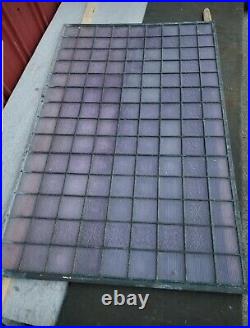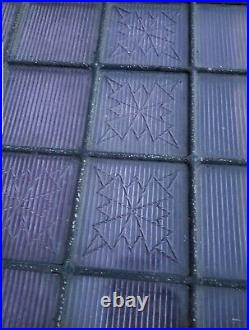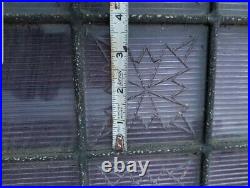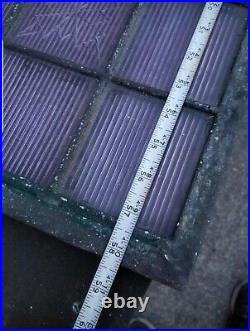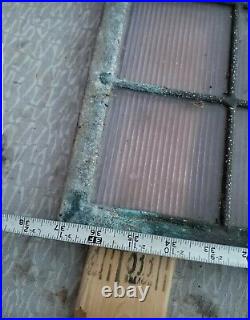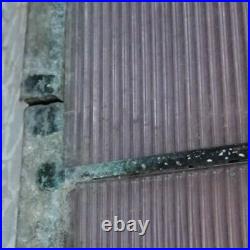This fantastic 38″ x 58″ Lavender color (manganese content) window tile has a solid surround with runs between 4″ x 4″ Prism and Thunderbolt Wave “aka” Snowflake design tiles. There are 126 total tiles. 34 Thunderbolt Wave tile with prism back. 92 standard Prism tile. There is one crack in the outside edge trim, no apparent cracks in any tile. Crack in edge is shown in pictures. Glass, Zinc, Lead, Manganese. Read the full description: (glassion. Org). All original & manufactured in an era when both architecture & style were paramount. In the late 1800′s and early 1900′s these glass tiles were utilized as part of a state of the art lighting method known as “Daylighting”. Allowing daylight to be naturally optimized – to wax and wane to your hearts content. All while magically refracting the sun in as many ways as the imagination will wander. Popularized by the Luxfer Prism Company & Frank Lloyd Wright at the turn of the 20th century during the Arts & Crafts movement. Continuing well beyond the Edwardian & Art Deco periods. Providing a wide array of uses from stylized transom windows in ornate Victorian homes, to industrial installations that both beautified storefronts & adorned factories. Today, reimagined as a forilux a window that hangs as a separate screen in front of existing window. Translated from Latin “Luxfer” is “lux” for light, and “ferre”, meaning to carry. The Luxfer Prism Company started life in October 1896 as the Radiating Light Company, founded by James G. Pennycuick to commercialize his patent No. 312,290 of 1882 for “an improvement in window-glass”. His improvement was the addition of horizontal prisms to the back side of square glass tiles, which redirected sunlight from windows where it was plentiful, back deep into rooms where light was scarce, reducing the need for artificial lighting and light wells. Luxfer hired “prominent physics professor and spectroscopist”, Henry Crew (Northwestern University), and his assistant Olin H. Basquin to develop scientific basis for company products. Luxfer is the best known name in prism glass, known particularly for their association with Frank Lloyd Wright, who designed some of their “Iridian” prism tiles. Of his 41 patented designs, only the well-known “flower” pattern was produced. Luxfer was eventually bought by American 3-Way Prism Company, their main competitor, forming the American 3-Way Luxfer Prism Company. Luxfer American 3-Way Prism Tile Designs & Styles: (Snowflake, Lens Back). Manufactured by American 3-Way, featuring the “Snowflake” or “Thunderbolt” pattern. Manufactured by Luxfer Prism Company known as “Lens Back”, “Wave”, “Turtleback” or “Panel” style tiles. The manganese content used in glass prior to 1915 created a chemical reaction by the sun causing it to turn an amethyst purple color. This type of purple glass became very popular and was marketed as Sun Purple or Sun Glass. The clear versions were not exposed to as much light. The brown tile is a rare custom or special order version. The lens backs of the 3 Way-Luxfer Prism tile catch the light rays from the sides and direct these back into the room, adding to the daylight. By this means, a room is illuminated with absolutely no cost. LOCATED outside Muncie, Indiana, about 65 miles north of Indianapolis. Thank you for lookin. This item is in the category “Antiques\Architectural & Garden\Stained Glass Windows”. The seller is “sueannk” and is located in this country: US. This item can be shipped to United States.
- Type: Transom Window
